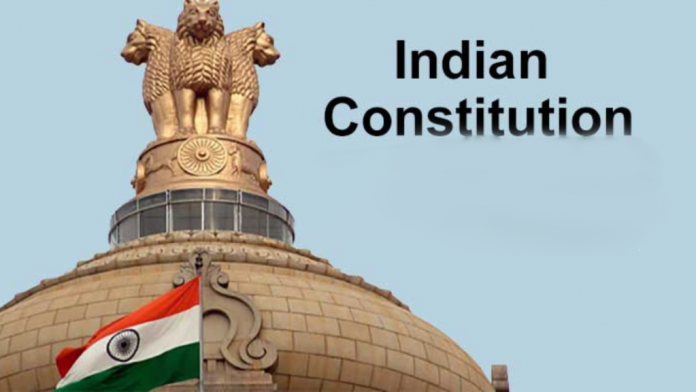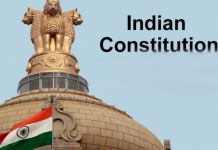This article is written by Gauri Saxena, an LLM student from Dr. DY Patil College of Law, Navi Mumbai. This article covers exhaustive research on Article 280 of the Indian Constitution and everything you need to know about the Finance Commission.
It has been published by Rachit Garg.
Table of Contents
Introduction
When the Constitution of India was being framed, a need for a body to regulate the distribution of tax proceeds between the union and states and among states was felt as per the arrangement provided by the Constitution and contemporary requirements. In order to fulfill their commitments, states incur expenses that are out of proportion to their earnings, which causes vertical disparities between the union and state governments. But states are more effective at addressing these issues because they can more accurately serve the interests and worries of their people.
Various historical contexts or resource donations lead to horizontal imbalances between state governments, which can grow over time. The law minister in charge at that time, Dr. B.R. Ambedkar, decided to overcome these disparities by establishing the Finance Commission. Therefore, on November 22, 1951, Article 280 was added, which brought the Finance Commission into force with its headquarters in New Delhi.
The Finance Commission
The Finance Commission is a constitutional body since it is mentioned in the Constitution of India and is there to carry out additional functions. It serves additional purposes and can be altered or added to without a constitutional amendment, not by some regular bill. The Indian Constitution serves as a basis for the capabilities and standards of the constitutional bodies. Compared to other organizations or bodies operating in India, these organizations are regarded as being more remarkable, strong, and superior.
Hence, a constitutional amendment is necessary if the authority of activities pertaining to these bodies is to be changed in any way. It is quasi-judicial in nature. It is formed every five years or at an earlier time (if necessary) by the President of India. The Finance Commission has been provided in the Indian Constitution as part of the scheme for the division of financial resources between two different sets of governments. This Commission’s work is distinguished by two distinctive features: resolving vertical disparities between the central government’s taxation powers and expenditure commitments and equalizing all public services across states. Currently, the fifteenth Finance Commission, constituted in 2017, is going on with its chairman, N.K. Singh.

According to Article 280,
- The President of India should lay out a Finance Commission in two years of the Indian Constitution’s reception and every five years thereafter.
- The Commission shall be tasked with making recommendations to the President on:
- allocation between the Union and the States of the net earnings of taxes that are to be, or maybe, divided between them; the distribution between the States of the respective shares of those earnings;
- the principles that should govern grants from the Consolidated Fund of India to states;
- or any matter assigned to the Commission by the President.
- The Commission shall specify its method of operation and shall have such powers in carrying out its responsibilities as Parliament may grant by law.
According to Article 281, the rules that the Finance Commission will make are generally in similarity to the prerequisites of the Constitution as well as the reason for the move made on them, must be approved by the House of the People (Lok Sabha) and the Council of States (Rajya Sabha).
The Finance Commission works in collaboration with all the governments, which helps it formulate fiscal policies for the union and states. There have been fifteen finance commissions to date; each has its distinctiveness.
The President of India decides the tenure of the members of the Finance Commission, and in specific conditions, the members are appointed again. The members should serve on the Commission part-time or full-time as the President mandates.
The members are paid as per the arrangements of the Constitution.
Key role of the Finance Commission
- The critical capability of the Finance Commission in India is to go about as an instrument to split continues divisible taxes between the states and the union government or, in the instances of taxes that are gathered with the aid of the central government but the proceeds of which are dispensed between the states, to decide the standards of such allocation.
- The Finance Commission of India also decides the ideas for administering the grants in aid of the earnings of states out of the consolidated fund of India. It is a fundamental quality of the Indian Finance Commission. The Commission has the obligation to ponder any matter being counted and alluded to the Commission by the President in the movement of sound finance.
- Under Article 280, the President presents the Finance Commission’s ideas to each House of Parliament, along with the reasoning for the move to be taken in the light of the ideas.
Functions of the Finance Commission
The Finance Commission is responsible for making recommendations to the President of India concerning the following:
- The principles governing the centre’s grants to states from the Consolidated Fund of India.
- The appropriation of net tax earnings among states and the centre.
- The Finance Commission assesses the increase in a state’s consolidated fund to include the resources of state panchayats and municipalities.
- How can the resources of a state’s panchayats and municipalities be increased provided they are in line with the Finance Commission of the respective state.
- The Finance Commission has enough authority to carry out its functions within the scope of its activity.
- The recommendations of the Commission, as well as an explanation of the government’s actions in response to them, are established before the Houses of Parliament.
- It can summon witnesses and request that any office or court produce public documents or records.
Composition
The Finance Commission consists of the following members:
Chairman
He is the leading member of the Commission and directs its activities. He ought to have previous experience in public affairs.
Members
The number of members, apart from the Chairman are four.
The qualifications of the Commission members, as well as their criteria, are statutorily determined by Parliament.
Appointment and qualification of the chairman and members
Appointment
According to Article 280 of the Constitution, the President appoints the Finance Commission. According to the Finance Commission [Miscellaneous Provisions] Act of 1951 and the Finance Commission (Salaries and Allowances) Rules, 1951, the Chairman of the Commission is chosen from among talented experts in public affairs, and the four other different individuals are chosen from among individuals who have the required qualifications.
Qualification
- Are or have been, or the right fit for the appointment of Judges of any High Court; or
- Have an exceptional mastery of Government funds and records; or
- Have expansive learning of monetary issues and organizational arrangement; or
- Have an intensive comprehension of financial matters.
Grounds for disqualification of the chairman and members
If any member of the Finance Commission is found to be:
- of an unstable mind,
- involved in a heinous crime,
- If a conflict of interest arises,
Such a member is disqualified.
Articles dealing with grants
Article 275
This Article mentions the grants from the Union to certain states.
- India’s Consolidated Fund will be required with so many totals as Parliament may by regulation propose as awards in help of the incomes of those states, as Parliament might find out that a state needs extra assistance and backing and separate totals might be set for discrete states.
Provided, however, that such capital and recurring sums may be essential to facilitate that state to cover all the expenses of such developmental projects as may be conducted by the state with the permission of the Scheduled Tribe in that state, or improving the level of management of the Scheduled Areas in that state to that of the management of the rest of the areas of that state, shall be compensated out of the Consolidated Fund of India as grants in aid of the revenue of that state.
- Till the time Parliament makes statutory requirement under clause (1) the privileges bestowed on Parliament so under clause are redeemable by the President by order and also any order made by the President under this clause is susceptible to any provision made by the Parliament:
Given, however, that after the formation of the Finance Commission no order under this clause shall be released by the President unless the Finance Commission suggestions are taken into account.
Article 282
Article 282 of the Indian Constitution talks about discretionary grants.
The union or a state out of its revenues may make grants for any public purpose, despite that the objective is not one concerning which Parliament or the Legislature of the State, as the case may be, may make laws.
Here, no recommendation has to be made to the Finance Commission. Therefore, it can be said that this article lessens the powers of Article 280.
Fiscal Responsibility and Budget Management Act
The year was 2000 when the Atal Bihari Vajpayee government proposed the Bill on Fiscal Responsibility and Budget Management (FRMB) in India’s Parliament to give legal cover for fiscal discipline to be incorporated in the country. Finally, in the year 2003, the FRMB Act (hereinafter, the Act) was eventually passed. It affirms the goals for the government to define the financial discipline, improve public fund management, enhance fiscal responsibility, and reduce fiscal deficits.
Section 1 of this Act states that this Act applies to the whole of India.
Section 2 talks about the definitions of fiscal deficit and fiscal indicators as follows:
Definition of fiscal deficit
The excess of total payments from the Consolidated Fund of India besides the debt repayment over receivables into the Fund, apart from debt repayment, is called the fiscal deficit.
Definition of fiscal indicators
It refers to methods such as numerical ceilings and proportions of GDP that may be recommended for assessing the central government’s financial position.
Aim of the Act
The primary goal of this Act is to hold the union government accountable for making sure intergenerational fairness and justice in fiscal management and long-term macroeconomic equilibrium.
Objectives of the Act
- Reduce fiscal deficit.
- The goal for the government to establish financial discipline.
- Provide efficient debt management and macroeconomic stability.
- Transparency should be initiated in India’s fiscal management processes.
- The long-term goal was to help implement a more efficient allocation of India’s debt.
- Aimed at maintaining better coordination between fiscal and monetary policy.
The characteristics of the Act
It requires the government to submit the following documents to Parliament each year, together with the Union Budget:
- Statement of medium-term fiscal policy
It outlines the three-year rolling targets for five distinct fiscal indicators in relation to GDP at market rates, which include revenue deficit, fiscal deficit, effective revenue deficit, tax to GDP ratio, and the amount remaining as Union Government Debt at the end of the year.
- Statement on the macroeconomic framework
A description of the economy is given in the statement. An evaluation of the growth rate of GDP, the government’s fiscal position, and the economy’s balance in the external sector are all included.
- Statement of the fiscal policy strategy
For the current fiscal year, it reveals the government’s priority areas for taxation, spending, loaning and making investments, prescribed pricing, loans, and guarantees.
It was proposed by the Act that the medium-term economic policy statement project the shortfall, fiscal deficit, government income, and total estimated liabilities as a percentage of GDP (Gross Domestic Product).
Effectiveness of the Act
This Act has been in effect for several years, however the government is yet to meet the targets set. It capped financial debt at 3% of the GDP. The Act has indeed been modified numerous times. The government made changes in 2013 by introducing the idea of a sufficient income shortage. This means that the effective revenue deficit is equal to the revenue deficit excluding the subsidies to states for capital asset creation.
The rules were also amended in 2018 and most recently to require a target of 3.1% for March 2023. In 2016, NK Singh formed a committee to suggest amendments to the Act and recommended that the government target a fiscal deficit of 2.5% by 2023. The government claims that the previous FRBM Act targets were too static.
NK Singh Committee
- The chairman of the committee was former Revenue and Expenditure Secretary Nand Kishore Singh.
- The report by NK Singh Committee was completed and submitted in 2017.
- Due to the greater and sometimes adverse effects of fiscal policy on the economy, the NK Singh Committee on the FRBM Act came into being to practice fiscal prudence.
- This committee came into being to focus on different factors that are required for determining the FRBM targets.
Recommendations of the NK Singh Committee
- Replacement of the FRBM Act 2003 with the Debt Management and Fiscal Responsibility Bill, 2017.
- By 2022-23, the union government’s debt to GDP ratio should be 38.7% and the state government’s should be 20%.
- The fiscal deficit target should be 2.5% of the GDP by FY (Financial Year) 2022–23.
- The debt path to be followed by each state based on their track record of fiscal health and prudence should be recommended by the 15th Finance Commission.
- The proposed legislation makes borrowing from the Reserve Bank of India illegal except in the following circumstances:
- The Centre must meet a temporary shortfall in receipts.
- RBI subscribes to the government securities to finance any deviations from specified targets.
- RBI purchases government securities on the secondary market.
- Target commitments could deviate under certain circumstances, such as a national calamity, war, agricultural collapse, structural reforms in the economy, and real output being less than 3%.
- The fiscal council’s responsibilities would include:
- Preparing multi-year fiscal forecasts,
- Recommending changes to the fiscal strategy
- Improving the quality of fiscal data
- Advising the government to take corrective action if the Bill is not followed.
- The setting up of an autonomous fiscal council that deals with the preparation of multi-year fiscal forecasts, improves fiscal data quality, and could advise the government on fiscal matters.
- Monetary and fiscal policies should complement each other and help achieve economic stability and growth.
Targets and Fiscal Indicators as per the FRBM Act
- By March 31, 2021, the government must limit the fiscal deficit to 3% of the GDP by March 31, 2021.
- The central government’s debt must be confined to 40% of the GDP by the year 2024–25.
Escape clause for the centre
Section 4(2) of the Act allows the Centre to surpass the annual fiscal deficit goal if certain conditions are met, such as:
- National safety
- War
- A national disaster
- Agriculture has failed
- Reforms in the structure
- A quarter of real output growth that is at least 3% lower than the previous four quarters’ average.
During the global financial crisis of 2008-09, the Centre used targeted fiscal stimulus, such as tax cuts to boost demand and higher spending on public projects to create jobs and public assets, to mitigate the effects of global stagnation. It resulted in a fiscal deficit of 6.2%, up from a budgeted target of 2.7%.
Types of deficits
There are three types of budget deficits in India, namely:
- Revenue deficit
- Fiscal deficit
- Primary deficit
Before we understand each deficit in detail, it is important to know exactly what a deficit is.
A budgetary scenario in which spending exceeds earnings is referred to as a deficit. It is a practice adopted for financing excess expenditure with outside resources. The expenditure gap is financed by either the printing of currency (not followed in India) or borrowing (from RBI, international banks, or funding from the market in the form of government securities).
For example, if your monthly income and expenditure are 50K and 30K respectively, in a month due to an emergency or any other situation, you are supposed to make a payment of ₹40K.
In this scenario, due to your monthly expenditure of 30K, you are left with just 20K. To make the payment of 40K, you will borrow ₹20K from a bank or some external source.
This is a case of a deficit as the total expenditure in that particular month was ₹80K but your earnings were 50K (lower than the required amount).
The budget is divided into two parts: revenue and capital.
There are two types of income, or revenue: receipt and expenditure. Revenue is generated by using direct and indirect taxes as well as non-taxes. Salary and benefits, inventory, rent, electricity, insurance, stationery, postage, and taxes are illustrations of expenditure.
These are consumptions that neither make resources nor diminish an organization’s liabilities. It is recurring in nature and is very essential for maintaining the daily operations of a business or organization.
Capital is also of two types: receipt and expenditure. Capital receipt refers to the income generated from assets. For example, the selling of government property or its shares of PSUs (Public Sector Undertakings), etc. Capital expenditure means the amount spent on building assets like hospitals, roads, and airports.
A maximum part of the government budget is spent on revenue expenditure.
Revenue deficit (RD)
A revenue deficit is the excess of a country’s total revenue expenditure over its total revenue receipts. It just applies to the government’s income uses and income receipts (and not its capital expenditure or receipts). An income deficiency implies that the authorities need more income to run their departments conventionally. It forces the government to either disinvest or cover the shortage by borrowing.
In the case of a revenue deficit, the government usually tries to curtail its expenses or increase its tax and non-tax receipts. This can be done by introducing new taxes or increasing the tax on people in higher-earning slabs.
| Revenue deficit = Total revenue expense – total revenue receipts |
Fiscal deficit (FD)
The excess of total (revenue and capital) expenditure over total (revenue and capital) receipts, excluding borrowings, is called a fiscal deficit. It determines the amount needed by the government for its expenditures (i.e., schemes, etc., and not just to run the government). A huge fiscal shortfall infers a significant amount of borrowing, i.e., the distinction between total use and (revenue in addition to non-debt capital receipts).
It is calculated as a percentage of Gross Domestic Product (GDP), or as whole money spent exceeding complete income. In either case, the income figure consists of only taxes and different earnings and does not contain money borrowed to make up the difference.
| Fiscal deficit = Total expenditure of the government – total income of the government |
The government allocates funds in its budget for numerous initiatives, including payments of salaries, pensions, etc. (revenue expenditure) and the formation of property such as infrastructure, development, and so on in the expenditure segment (capital expenditure).
The income aspect comprises two variables:
- revenue from centre-levied taxes and
- income from non-tax variables.
The amount generated from corporation tax, income tax, customs duties, excise duties, and GST, among other things, constitutes taxable income. Meanwhile, non-taxable income is derived from external grants, interest receipts, dividends and profits, and receipts from the Union Territories, among others.
NOTE: A huge monetary shortage might be valuable to the economy in the event that assets are utilized to fabricate useful resources and not just to run the government, like expressways, roads, ports, and air terminals, which upgrade financial development and make occupations.
Primary deficit (PD)
A primary deficit is the fiscal deficit of the current year excluding the interest payments on previous borrowings. The financial shortfall mirrors how much is being borrowed by the government alongside interest installments. The primary deficit shows the amount of borrowing after subtracting interest payments.
For example, in year one, you take a loan of ₹50K on which you are required to pay interest of ₹5K every year. So, in the second year (counted from the year of borrowing), you will be paying ₹55K (50K+5K). And in the third year, you will be paying ₹61K (55K+5K). In this case, your primary deficit will be 50K as that is the actual amount you needed, while the additional 11K is the interest payment that is subtracted while calculating the primary deficit. Here, 61K is the fiscal deficit (the overall debt including the interest).
It portrays the fiscal deficit for a given year on the off chance that no interest was paid. It dismisses the preceding government’s loans in the proceeding fiscal year. It is worried about the welfare of our economy.
| Primary deficit = Fiscal deficit – interest payments |
Conclusion
As an independent body, the Finance Commission has filled a significant need and served a treasured purpose. It filled in as a specialist in cooperative energy in a troublesome and complex society like India for the smooth working of a federal system.
Frequently Asked Questions (FAQs)
Did the government of India use the pandemic as a reason for the increased fiscal deficit?
Yes, the COVID-19 pandemic has already been used by the government as a national calamity clause in the previous year.
Is the wealth tax direct or indirect?
Wealth tax comes under the category of direct tax.
Is it true that the union government has the liberty to dismiss the Finance Commission’s suggestions?
The union government has the option to reject or dismiss any suggestions made by the Finance Commission.
Do all states have different finance commissions?
Yes, all the states have a state finance commission.
Which states do not have separate finance commissions?
Mizoram, Meghalaya, and Nagaland have been exempted from forming the state finance commission.
The state finance commission is appointed by whom?
The state finance commission is appointed by the governor of the respective state.
References
- https://fincomindia.nic.in/ShowContentOne.aspx?id=8&Section=1
- https://fincomindia.nic.in/default.aspx
- https://finance.cg.gov.in/state_finance_commission/FSFC/State%20Finance%20Report/English/Chap-1.pdf
- https://www.business-standard.com/about/what-is-frbm-act
- https://indianexpress.com/article/explained/global-financial-crisis-2007-08-indian-economy-lehman-brothers-fall-5359333/#:~:text=After%20doing%20better%20than%20what,2.7%25%20in%20the%20previous%20year.
- https://dea.gov.in/sites/default/files/Volume%201%20FRBM%20Review%20Committee%20Report.pdf
Students of Lawsikho courses regularly produce writing assignments and work on practical exercises as a part of their coursework and develop themselves in real-life practical skills.
LawSikho has created a telegram group for exchanging legal knowledge, referrals, and various opportunities. You can click on this link and join:
Follow us on Instagram and subscribe to our YouTube channel for more amazing legal content.












